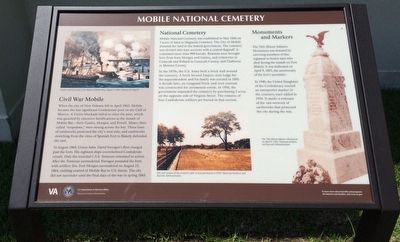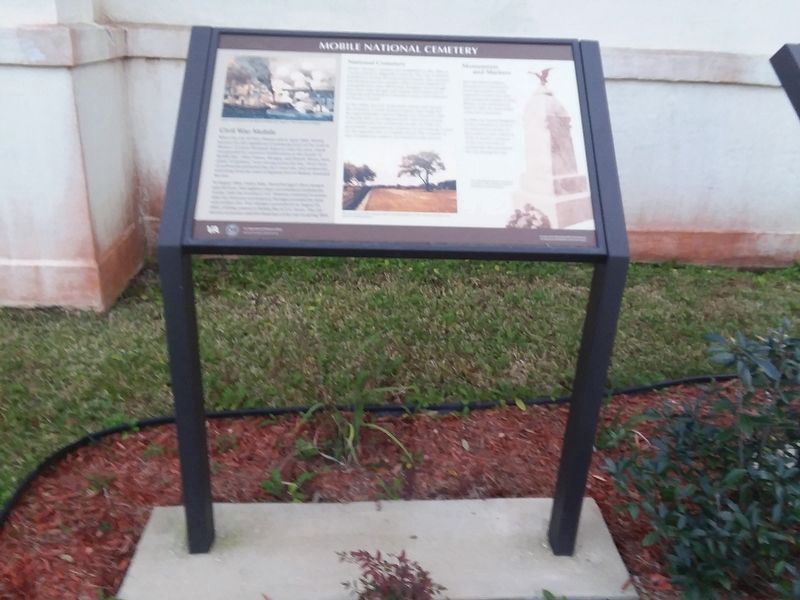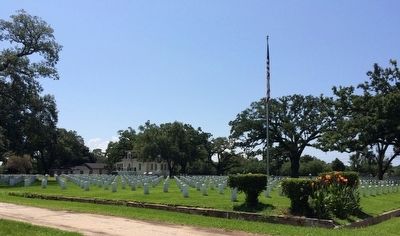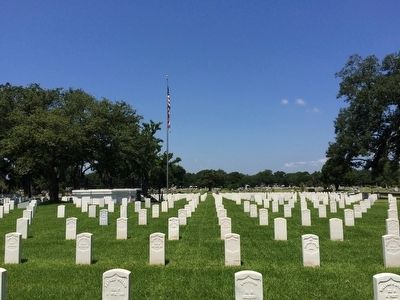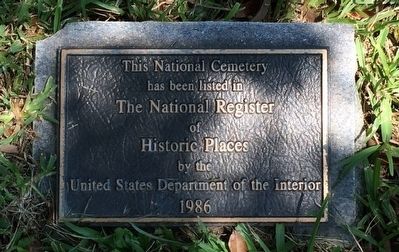Mobile in Mobile County, Alabama — The American South (East South Central)
Mobile National Cemetery
Mobile National Cemetery was established in May 1866 on 3 acres of land in Magnolia Cemetery. The City of Mobile donated the land to the federal government. The Cemetery was divided into four sections with a central flagstaff. It contained more than 900 burials. Remains were brought here from forts Morgan and Gaines, and cemeteries in Conecuh and Pollard in Conecuh County and Claiborne in Monroe County.
In the 1870s, the U.S. Army built a brick wall around the cemetery. A brick Second Empire-style lodge for the superintendent and his family was erected in 1881. A decade later, an octagonal brick-and-iron rostrum was constructed for ceremonial events. In 1936, the government expanded the cemetery by purchasing 3 acres on the opposite side of Virginia Street. The remains of four Confederate soldiers are buried in that section.
When the city of New Orleans fell in April 1862, Mobile became the last significant Confederate port on the Gulf of Mexico. A Union blockade failed to close the port, which was guarded by extensive fortifications at the mouth of Mobile Bay — forts Gaines, Morgan, and Powell. Mines, then called “torpedoes,” were strung across the bay. Three lines of earthworks protected the city’s west side, and earthworks stretching from the cities of Spanish Fort to Blakely defended the east.
In August 1864, Union Adm. David Farragut’s fleet charged past the forts. His eighteen ships overwhelmed Confederate vessels. Only the ironclad C.S.S. Tennessee remained in action. After the Tennessee surrendered, Farragut pounded the forts with artillery fire. Fort Morgan surrendered on August 23, 1864, yielding control of Mobile Bay to U.S. forces. The city did not surrender until the final days of the war in spring 1865.
The 76th Illinois Infantry Monument was donated by surviving members of this regiment to honor men who died during the assault on Fort Blakely. It was dedicated on April 9, 1892, the anniversary of the fort’s surrender.
In 1940, the United Daughters of the Confederacy erected an interpretive marker in the cemetery tract added in 1936. It marks a remnant of the vast network of earthworks that protected the city during the war.
Erected by the U.S. Department of Veterans Affairs.
Topics and series. This historical marker is listed in these topic lists: Cemeteries & Burial Sites • War, US Civil • Waterways & Vessels. In addition, it is included in the National Cemeteries series list. A significant historical year for this entry is 1866.
Location. 30° 40.422′ N, 88° 3.835′ W. Marker is in Mobile, Alabama, in Mobile County. Marker can be reached from Virginia Street, 0.1 miles east of South Ann Street. Located behind the superintendent's lodge. Touch for map. Marker is at or near this postal address: 1202 Virginia Street, Mobile AL 36604, United States of America. Touch for directions.
Other nearby markers. At least 8 other markers are within walking distance of this marker. Battle of Coffeeville Memorial (here, next to this marker); Battle of Mobile Bay Memorial (a few steps from this marker); CSS Alabama Memorial (a few steps from this marker); Crew of CSS H. L. Hunley Memorial (a few steps from this marker); The Markers In This Memorial Area (within shouting distance of this marker); Battle of Fort Blakely Monument (within shouting distance of this marker); A National Cemetery System (within shouting distance of this marker); Jewish Rest Magnolia Cemetery (about 600 feet away, measured in a direct line). Touch for a list and map of all markers in Mobile.
Also see . . .
1. Mobile National Cemetery Mobile, Alabama. (Submitted on August 9, 2015, by Mark Hilton of Montgomery, Alabama.)
2. Magnolia Cemetery history. (Submitted on August 9, 2015, by Mark Hilton of Montgomery, Alabama.)
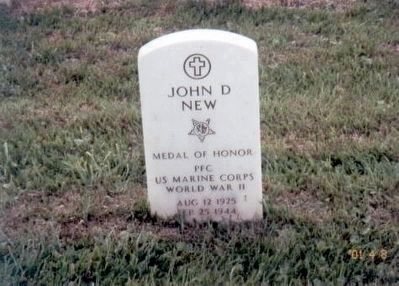
Photographed By Don Morfe, April 8, 2001
7. John Dury New - WW II Congressional Medal of Honor Recipient
Buried in Mobile National Cemetery, Section 7, Site 2147. Killed in Action. Private First Class, U.S. Marine Corps
Citation: For conspicuous gallantry and intrepidity at the risk of his life above and beyond the call of duty while serving with the 2d Battalion, 7th Marines, 1st Marine Division, in action against enemy Japanese forces on Peleliu Island, Palau Group, 25 September 1944. When a Japanese soldier emerged from a cave in a cliff directly below an observation post and suddenly hurled a grenade into the position from which 2 of our men were directing mortar fire against enemy emplacements, Pfc. New instantly perceived the dire peril to the other marines and, with utter disregard for his own safety, unhesitatingly flung himself upon the grenade and absorbed the full impact of the explosion, thus saving the lives of the 2 observers. Pfc. New's great personal valor and selfless conduct in the face of almost certain death reflect the highest credit upon himself and the U.S. Naval Service. He gallantly gave his life for his country.
Citation: For conspicuous gallantry and intrepidity at the risk of his life above and beyond the call of duty while serving with the 2d Battalion, 7th Marines, 1st Marine Division, in action against enemy Japanese forces on Peleliu Island, Palau Group, 25 September 1944. When a Japanese soldier emerged from a cave in a cliff directly below an observation post and suddenly hurled a grenade into the position from which 2 of our men were directing mortar fire against enemy emplacements, Pfc. New instantly perceived the dire peril to the other marines and, with utter disregard for his own safety, unhesitatingly flung himself upon the grenade and absorbed the full impact of the explosion, thus saving the lives of the 2 observers. Pfc. New's great personal valor and selfless conduct in the face of almost certain death reflect the highest credit upon himself and the U.S. Naval Service. He gallantly gave his life for his country.
Credits. This page was last revised on December 11, 2021. It was originally submitted on August 9, 2015, by Mark Hilton of Montgomery, Alabama. This page has been viewed 615 times since then and 41 times this year. Photos: 1. submitted on August 9, 2015, by Mark Hilton of Montgomery, Alabama. 2. submitted on December 10, 2021, by Craig Doda of Napoleon, Ohio. 3, 4, 5, 6. submitted on August 9, 2015, by Mark Hilton of Montgomery, Alabama. 7. submitted on March 7, 2016, by Don Morfe of Baltimore, Maryland.
